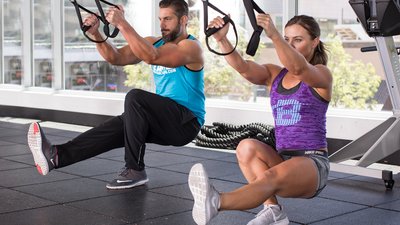When it comes to developing strong, muscular legs, there's no denying the value of heavy weights. Loading up a barbell with lots of iron is a tried-and-true way to add muscle, but it's not the only way. Utilizing a TRX or a similar suspension trainer every few workouts, or as a regular part of your lower-body training, can be just the thing to make you a more well-balanced, injury-resistant athlete.
You may associate them with home training and doorways, but elite coaches swear by suspension straps, too.
"A suspension trainer is an incredibly versatile way to strategically apply force during lower-body exercises," says Jennifer Novak, a performance recovery coach and the owner of PEAK Symmetry Performance Strategies. "One benefit of suspension training is the ability to focus on underperforming muscles on one side of your body, without stronger muscles on the other side taking over."
Even if you're not laboring under severe muscle imbalances, suspension straps offer another benefit any lifter can get on board with: making muscles work harder! Research shows that suspension training increases muscle-activation patterns compared to the same exercises performed on stable surfaces.[1]
And the best moves for suspension training are also some of the simplest to perform! Next time you have access to one, give these leg exercises a try.
Suspension Strap Sprinter
The sprinter is perfect for firing up your legs before diving into the meat of any workout. While it gives a serious cardiovascular challenge, this exercise also engages your calves, quads, glutes, and core—all while stretching your hip flexors and calves. Start with the basic movement, eliminating the optional knee tuck or plyometric hop, then progress to the more challenging versions once you've got your form down and your legs are warmed up.
Directions
- Start in a plank position, with your body angled at roughly 45-degrees, holding the suspension straps in each hand at your chest. Keep your core engaged and your body forming a straight line from heels to head.
- Holding your torso steady, step your right foot backward, planting the ball of your foot on the ground as you bend your left knee, entering a sprinter position. Step your foot back to start. (Optional: Instead of stepping your foot to start, drive your right knee forward, bending your right hip, as if you were taking off from a starting line. For an even greater challenge, hop off your left foot as you drive your right knee forward.)
- Continue for 30 seconds on one leg before switching sides. Perform a total of three rounds.
Squat and Squat Jump
If you struggle with range of motion during your squat or have developed a few bad form habits over the years, the suspension-strap squat is an excellent way to perfect the movement pattern while working on hip mobility. During the exercise, you'll actually use the suspension straps as a counterbalance, which allows you to deepen your range of motion while reducing some of the load.
When you're ready, it's easy to progress this movement by adding a jump.
Directions
- Stand tall with your arms in front of you and the suspension straps taut. Lean back slightly, so your arms are extended directly out from your chest, with your weight in your heels and your body forming a straight line from heels to head.
- Keeping your arms straight, press your hips back and bend your knees while lowering your glutes toward the floor. When your knees and hips are bent at 90 degrees, check your form to ensure your knees are aligned with your toes.
- Press through your heels and extend your knees and hips to return to start. Perform 3 sets of 12-15 repetitions. For a greater challenge, add a jump to the exercise.
Suspended Lunge
The suspended lunge is an excellent way to enhance your lower-body balance while evening out side-to-side muscular imbalances. If you like Bulgarian split squats, with or without weight, you'll find these offer the same benefits and then some. Once you've mastered the basic movement, you can add a plyometric hop and even a tuck jump to enhance your explosive power.
The most advanced version of the lunge, the plyo lunge with a tuck jump (also known as the lunge progression combo) is a favorite of Curtis Williams, former NFL player and founder of Training C.A.M.P.
"It challenges your athleticism and stability from your ankle, knee, and hip," Williams says. "Athletes, including everyday athletes, need to be able to keep their balance and produce force unilaterally."
Directions
- Position the suspension straps at roughly calf height. Kneel on the ground, facing away from the straps, and place your right foot into the foot strap. Press through your left foot to stand. You should be in the start of a lunge position, your right foot extended and suspended behind you, your weight primarily in the heel of your left foot.
- Keeping your weight in your left heel, bend your left knee as you press your right leg backward, lowering into a lunge. Check to make sure your left knee doesn't extend over your left toes.
- Press through your left heel to return to the starting position. Perform 3 sets of 8-12 repetitions per side.
Pistol Squat
Traditional pistol squats can be challenging even for the strongest athlete. This is because in addition to unilateral leg strength and balance, they also require a lot of hip flexibility and control. If you struggle to perform pistol squats unassisted, a suspension trainer can offer the help you need to perform the pistol squat through a full range of motion.
Directions
- Stand facing the suspension straps and hold a handle in each hand, with your elbows bent and close to your sides, and the straps pulled taut. Extend your right leg with your knee straight and your foot hovering off the ground. With your weight in your left heel, lean back slightly. This is the starting position.
- Press your hips back and bend your left knee, lowering yourself into a deep squat, all while keeping your right leg extended straight in front of you with your right foot off the floor. Allow your arms to straighten and extend to keep the straps taut to help you maintain the counterbalance you need to complete the movement. Check your form at the bottom of the squat to ensure your core is tight, your weight is in your supporting heel, and your left knee is aligned with your toes.
- From the bottom position, press through your left heel and extend your left leg to return to standing. You can use the straps for balance, but try not to use them to help pull yourself up—you want the movement to target your legs, not your arms. Perform 3 sets per leg, aiming to complete at least 6 repetitions per set with perfect form.
Hamstring Curls
Suspended hamstring curls force both legs to work independently, without the benefit of a ground reaction force to initiate the movement. This requires additional core engagement and control to perform the curl correctly. Just a few of these will probably seem incredibly difficult at first, but this is a good thing! Get strong at them, and your reward will be stronger and more resilient knees and hips, not to mention core.
Directions
- Lie on your back with your arms at your sides and your legs extended, with each heel anchored in one of the suspension straps.
- Engage your core and lift your hips from the ground until your body forms a straight line from your heels to your shoulder blades.
- Keeping your torso straight, your core tight, and your hips lifted, press through your heels and bend your knees, pulling your heels toward your glutes.
- When you've drawn your heels as close to your body as you can, reverse the movement and extend your legs to the starting position, keeping your hips lifted off the ground. Perform 3 sets of 10-15 repetitions.
Reference
- Harris, S., Ruffin, E., Brewer, W., & Ortiz, A. (2017). Muscle activation patterns during suspension training exercises. International Journal of Sports Physical Therapy, 12(1), 42–52.

